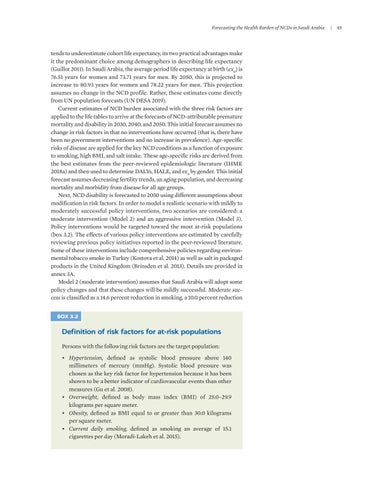Forecasting the Health Burden of NCDs in Saudi Arabia | 45
tends to underestimate cohort life expectancy, its two practical advantages make it the predominant choice among demographers in describing life expectancy (Guillot 2011). In Saudi Arabia, the average period life expectancy at birth (ex0) is 76.51 years for women and 73.71 years for men. By 2050, this is projected to increase to 80.93 years for women and 78.22 years for men. This projection assumes no change in the NCD profile. Rather, these estimates come directly from UN population forecasts (UN DESA 2019). Current estimates of NCD burden associated with the three risk factors are applied to the life tables to arrive at the forecasts of NCD-attributable premature mortality and disability in 2030, 2040, and 2050. This initial forecast assumes no change in risk factors in that no interventions have occurred (that is, there have been no government interventions and no increase in prevalence). Age-specific risks of disease are applied for the key NCD conditions as a function of exposure to smoking, high BMI, and salt intake. These age-specific risks are derived from the best estimates from the peer-reviewed epidemiologic literature (IHME 2018a) and then used to determine DALYs, HALE, and ex0 by gender. This initial forecast assumes decreasing fertility trends, an aging population, and decreasing mortality and morbidity from disease for all age groups. Next, NCD disability is forecasted to 2050 using different assumptions about modification in risk factors. In order to model a realistic scenario with mildly to moderately successful policy interventions, two scenarios are considered: a moderate intervention (Model 2) and an aggressive intervention (Model 3). Policy interventions would be targeted toward the most at-risk populations (box 3.2). The effects of various policy interventions are estimated by carefully reviewing previous policy initiatives reported in the peer-reviewed literature. Some of these interventions include comprehensive policies regarding environmental tobacco smoke in Turkey (Kostova et al. 2014) as well as salt in packaged products in the United Kingdom (Brinsden et al. 2013). Details are provided in annex 3A. Model 2 (moderate intervention) assumes that Saudi Arabia will adopt some policy changes and that these changes will be mildly successful. Moderate success is classified as a 14.6 percent reduction in smoking, a 10.0 percent reduction BOX 3.2
Definition of risk factors for at-risk populations Persons with the following risk factors are the target population: • Hypertension, defined as systolic blood pressure above 140 millimeters of mercury (mmHg). Systolic blood pressure was chosen as the key risk factor for hypertension because it has been shown to be a better indicator of cardiovascular events than other measures (Gu et al. 2008). • Overweight, defined as body mass index (BMI) of 25.0–29.9 kilograms per square meter. • Obesity, defined as BMI equal to or greater than 30.0 kilograms per square meter. • Current daily smoking, defined as smoking an average of 15.1 cigarettes per day (Moradi-Lakeh et al. 2015).

